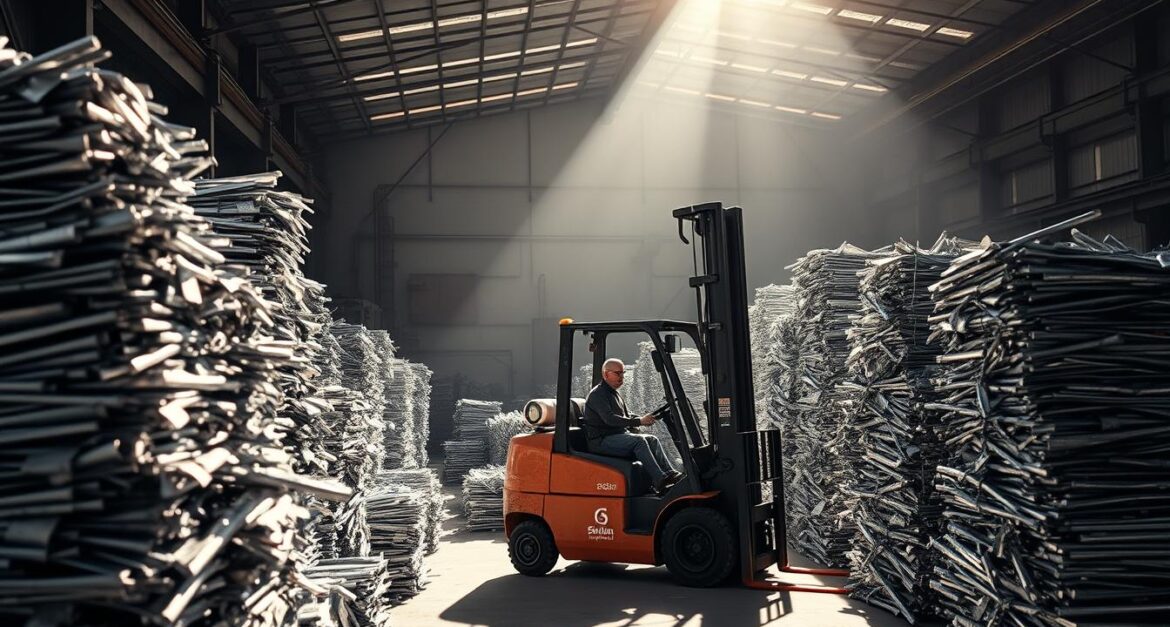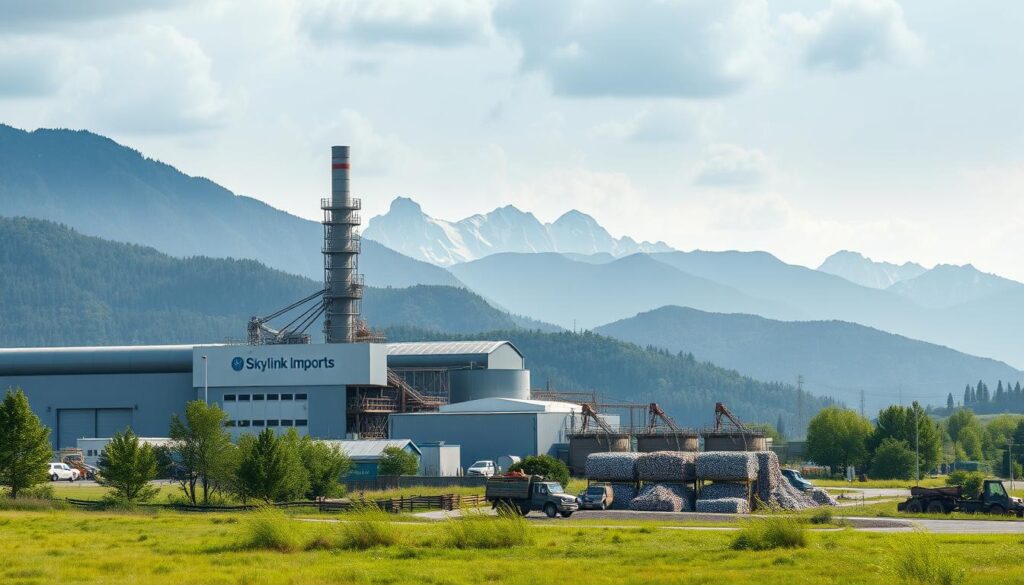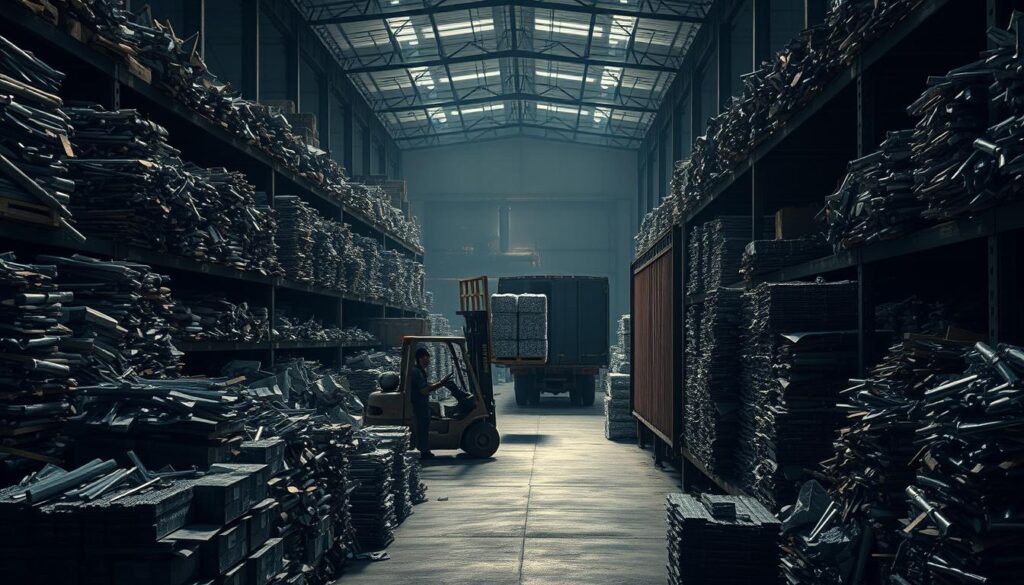
The world is witnessing a significant shift towards sustainable practices, and the metals industry is no exception. Aluminium scrap recycling plays a vital role in this transition, enabling the production of eco-friendly metals that are essential for modern manufacturing.
Skylink Imports, a global import-export solutions provider, is at the forefront of this industry, bridging the gap between manufacturers and markets with unmatched efficiency, reliability, and transparency. Their commitment to sustainability is evident in their focus on sourcing high-quality aluminium scrap.
Key Takeaways
- Aluminium scrap recycling is crucial for producing eco-friendly metals.
- Skylink Imports is a leading player in the global metals trade.
- The use of recycled aluminium reduces the environmental impact of metal production.
- Eco-metals are becoming increasingly important in modern manufacturing.
- Sustainable practices in the metals industry are on the rise.
The Global Aluminium Industry: Current Landscape and Challenges
The global aluminium industry is at a crossroads, facing both unprecedented demand and significant environmental challenges. As a critical component of various industries, including transportation, construction, and packaging, aluminium’s versatility and recyclability make it a valuable resource. However, the industry’s growth is accompanied by substantial ecological concerns that need to be addressed.
Production Statistics and Market Trends
The global aluminium market is characterised by a steady increase in demand, driven primarily by the transportation and construction sectors. In 2022, the global aluminium production reached 65.4 million metric tons, with a significant portion coming from primary production. The market is expected to continue growing, with an estimated annual growth rate of 3.5% through 2025.
| Year | Global Production (Million Metric Tons) | Growth Rate (%) |
|---|---|---|
| 2020 | 63.2 | 2.1 |
| 2021 | 64.5 | 2.5 |
| 2022 | 65.4 | 3.1 |
Environmental Impact of Primary Aluminium Production
Primary aluminium production is energy-intensive and results in significant greenhouse gas emissions. The production process involves the electrolysis of alumina, which requires substantial electrical energy, often generated from non-renewable sources. This leads to a considerable carbon footprint, with the aluminium industry accounting for approximately 1.1% of global CO2 emissions.

Resource Depletion Concerns
The extraction of bauxite, the primary source of aluminium, raises concerns about resource depletion and environmental degradation. Sustainable practices, such as recycling and efficient use of resources, are crucial to mitigating these impacts. The industry is moving towards more sustainable metal production practices, including the use of renewable energy sources and closed-loop recycling systems.
As the industry continues to evolve, the focus on environmentally friendly aluminium production methods will become increasingly important. This includes not only reducing the carbon footprint of primary production but also enhancing the recycling infrastructure to maximise the use of secondary aluminium.
Understanding Aluminium Scrap: Types, Grades, and Quality Metrics
Understanding the nuances of aluminium scrap is essential for effective recycling and quality control. Aluminium scrap, a vital component in the recycling industry, is categorised into various types and grades based on its source, composition, and quality.
Classification of Aluminium Scrap
Aluminium scrap is broadly classified into two main categories: old scrap and new scrap. Old scrap refers to aluminium products that have reached the end of their life cycle, such as used beverage cans and discarded aluminium parts. New scrap, on the other hand, consists of aluminium waste generated during manufacturing processes.
The classification further extends to specific grades based on the alloy composition and purity. Common grades include:
- Cast Aluminium: Derived from engine blocks, transmission cases, and other cast parts.
- Wrought Aluminium: Includes aluminium sheet, extrusions, and other wrought products.
- Mixed Aluminium: A combination of cast and wrought aluminium scrap.
Quality Determinants in Scrap Evaluation
The quality of aluminium scrap is determined by several factors, including:
- Alloy Composition: The specific mix of metals in the alloy affects its properties and recyclability.
- Purity: The presence of contaminants or other metals can impact the scrap’s value and usability.
- Physical Condition: The form and cleanliness of the scrap influence its processing and recycling efficiency.

International Standards and Grading Systems
To ensure consistency and quality in aluminium scrap trading, international standards and grading systems are employed. Organisations such as the Institute of Scrap Recycling Industries (ISRI) provide guidelines for scrap classification and quality control.
| Grade | Description | Typical Applications |
|---|---|---|
| Taint Tabor | Clean, uncoated aluminium sheet scrap | Recycling into new aluminium sheet products |
| Old Cast Aluminium | Used aluminium castings, such as engine blocks | Recycling into new cast aluminium products |
| Mixed Aluminium | A mix of cast and wrought aluminium scrap | Various recycling applications |
For more information on our aluminium scrap recycling services and how we contribute to the circular economy, please email us at info@skylinkimports.com.
The Circular Economy Model: Aluminium’s Perfect Fit
As the world shifts towards sustainable practices, the circular economy model emerges as a perfect fit for aluminium. This economic model, which emphasises the reuse and recycling of materials, aligns well with aluminium’s inherent properties.
Core Principles of Circular Economy in Metal Industries
The circular economy is based on three core principles: reduce, reuse, and recycle. In the context of metal industries, this translates into minimising waste during production, reusing metal products whenever possible, and recycling metals to produce new products.
Key strategies for implementing the circular economy in the metal industries include:
- Designing products for recyclability
- Implementing efficient recycling technologies
- Promoting the use of recycled materials
- Developing closed-loop production systems
Aluminium’s Infinite Recyclability Advantage
Aluminium is 100% recyclable without losing its properties, making it an ideal material for the circular economy. The recycling process for aluminium requires only 5% of the energy needed to produce primary aluminium, significantly reducing the carbon footprint of aluminium products.
The recyclability of aluminium creates a sustainable loop where aluminium products are continually cycled back into production, reducing the need for primary aluminium and the environmental impacts associated with its production.
Economic Benefits of Closed-Loop Systems
Closed-loop systems, where aluminium is continually recycled and reused, offer significant economic benefits. These include reduced production costs, decreased reliance on primary aluminium, and the creation of new business opportunities in the recycling sector.
| Economic Benefits | Description | Impact |
|---|---|---|
| Reduced Production Costs | Lower energy costs for recycling compared to primary production | Significant cost savings |
| Decreased Reliance on Primary Aluminium | Reduced exposure to volatile primary aluminium prices | Improved price stability |
| New Business Opportunities | Emergence of recycling industries and related services | Job creation and economic growth |
For more information on how aluminium recycling can benefit your business, contact us at +1 (403)266-9394 or +91-9041-543543 for inquiries.
Best quality Aluminium Scrap’s Role in Eco-Metals of the Future
As the world shifts towards sustainable production, the importance of premium aluminium scrap in eco-metals cannot be overstated. The concept of eco-metals is gaining traction in modern manufacturing, driven by the need for environmentally friendly materials that do not compromise on performance.
Defining “Eco-Metals” in Modern Manufacturing
Eco-metals refer to metals that are produced using sustainable practices, minimising environmental impact while maintaining high-performance characteristics. The use of high-quality aluminium scrap is crucial in this process, as it reduces the need for primary production, thereby lowering energy consumption and carbon emissions.
The production of eco-metals involves advanced recycling technologies that ensure the quality and purity of the final product. This not only supports the circular economy model but also provides manufacturers with materials that meet stringent environmental regulations.
How Premium Scrap Transforms into High-Performance Eco-Metals
The transformation of premium aluminium scrap into eco-metals involves several sophisticated processes. Initially, the scrap is sorted and processed to remove contaminants, ensuring a high level of purity. Advanced metallurgical techniques are then applied to refine the material, resulting in a product that is comparable to, if not superior to, traditionally produced metals.
This process not only conserves natural resources but also significantly reduces the environmental footprint associated with metal production. The resulting eco-metals exhibit excellent durability and performance, making them suitable for a wide range of applications, from automotive to aerospace industries.
Case Studies: Successful Eco-Metal Implementations
Several companies have successfully implemented eco-metals in their manufacturing processes, achieving significant environmental and economic benefits. For instance, a leading automotive manufacturer used eco-metals produced from high-quality aluminium scrap to reduce the weight of their vehicles, resulting in improved fuel efficiency and lower emissions.
Another example is an aerospace company that incorporated eco-metals into its aircraft components, benefiting from the material’s high strength-to-weight ratio and corrosion resistance. These case studies demonstrate the potential of eco-metals to transform industries and contribute to a more sustainable future.
Environmental Benefits of Aluminium Recycling
The environmental advantages of aluminium recycling are multifaceted, ranging from energy conservation to waste reduction. As the world shifts towards more sustainable practices, understanding these benefits is crucial for industries and consumers alike.
Energy Savings Compared to Primary Production
Recycling aluminium requires significantly less energy than producing primary aluminium. According to the Aluminium Association, recycling aluminium uses 95% less energy than producing it from raw materials. This substantial energy saving is due to the fact that recycling bypasses the energy-intensive electrolysis process required in primary production.
Energy consumption is a critical factor in the environmental impact of aluminium production. By reducing the need for primary production, aluminium recycling contributes to lower overall energy consumption in the aluminium industry.
Carbon Footprint Reduction Metrics
The reduction in carbon footprint is another significant environmental benefit of aluminium recycling. Studies have shown that recycling aluminium can reduce greenhouse gas emissions by up to 95% compared to primary production. This is largely due to the avoidance of emissions associated with bauxite mining and alumina refining.
Quantifying the carbon footprint reduction is essential for understanding the environmental value of aluminium recycling. Metrics such as tons of CO2 equivalent per ton of aluminium recycled provide valuable insights into the environmental benefits.
“Aluminium recycling is a critical component of a circular economy, offering substantial environmental benefits including energy savings and reduced greenhouse gas emissions.”
Waste Reduction and Landfill Diversion
Aluminium recycling also plays a vital role in waste reduction and landfill diversion. By recycling aluminium scrap, the amount of waste sent to landfills is significantly reduced. This not only conserves landfill space but also reduces the environmental impacts associated with waste disposal.
For more information on our sustainability initiatives, email us at info@skylinkimports.com. We are committed to promoting environmentally friendly practices in the aluminium industry.
Challenges and Solutions in the Aluminium Recycling Industry
As the demand for recycled aluminium grows, the industry must address its inherent challenges. The aluminium recycling industry is a complex system that involves multiple stakeholders, processes, and technologies.
Contamination Issues and Quality Control
One of the significant challenges in aluminium recycling is contamination. Contaminants can come in various forms, including other metals, dirt, and coatings on the aluminium. Effective quality control measures are crucial to mitigate these issues. Advanced sorting technologies and rigorous inspection processes can help in identifying and removing contaminants.
Implementing strict quality control protocols is essential for producing high-quality recycled aluminium. This involves not only the use of advanced technology but also training personnel to identify potential contaminants.
Collection and Logistics Hurdles
Another significant challenge is the collection and logistics of aluminium scrap. The scattered nature of aluminium waste, particularly from consumer goods like packaging and automotive parts, makes collection a logistical nightmare. Efficient collection systems are needed to gather scrap aluminium from various sources.
Developing streamlined logistics networks can help reduce the costs and environmental impact associated with transporting scrap aluminium to recycling facilities.
Innovative Approaches to Overcome Recycling Barriers
The industry is turning to innovative solutions to overcome these challenges. Advanced technologies, such as AI-powered sorting systems and more efficient melting technologies, are being developed to improve the quality and efficiency of aluminium recycling.
For instance, closed-loop recycling systems allow for the continuous recycling of aluminium without significant loss of quality. This approach not only reduces waste but also conserves energy and resources.
For more information on innovative recycling solutions, you can contact Skylink Imports at +1 (403)266-9394.
Technological Innovations in Aluminium Scrap Processing
Innovations in sorting and processing are enhancing aluminium scrap quality, paving the way for more efficient recycling processes. Companies like Skylink Imports are leveraging these technological advancements to improve their sourcing and procurement processes.
Advanced Sorting and Separation Technologies
The use of advanced sorting technologies, such as eddy current separators and sensor-based sorting systems, is revolutionizing the aluminium recycling industry. These technologies enable the efficient separation of aluminium from other materials, improving the quality of the recycled metal.
“The integration of AI and machine learning in sorting processes is a game-changer for the industry.” This quote highlights the significance of technological innovation in aluminium recycling.
Metallurgical Improvements in Recycling Processes
Metallurgical advancements are also playing a crucial role in enhancing aluminium recycling. Techniques such as advanced alloying and refining are improving the quality of recycled aluminium, making it suitable for high-performance applications.
- Improved alloying techniques for better material properties
- Advanced refining processes for higher purity aluminium
- Increased efficiency in recycling processes
Digital Solutions for Quality Control and Traceability
Digital solutions, including blockchain technology and IoT sensors, are being implemented to enhance quality control and traceability in aluminium recycling. These technologies provide real-time monitoring and data analysis, enabling more precise control over the recycling process.
By embracing these technological innovations, the aluminium recycling industry is poised to achieve significant improvements in efficiency, quality, and sustainability.
Canada’s Position in the Global Aluminium Recycling Market
Canada has emerged as a significant player in the global aluminium recycling market, driven by its robust infrastructure and commitment to sustainability. The country’s advanced recycling facilities and government initiatives have positioned it as a leader in the industry.
Current Infrastructure and Regional Recycling Hubs
Canada’s aluminium recycling infrastructure is well-developed, with numerous recycling facilities across the country. Major recycling hubs are located in provinces such as Quebec and Ontario, where large-scale aluminium production and consumption occur.
The infrastructure supports a closed-loop system, where aluminium scrap is collected, processed, and reused in various products, reducing the need for primary aluminium production and minimizing environmental impact.
Policy Framework and Government Sustainability Initiatives
The Canadian government has implemented policies to support sustainability in the aluminium recycling sector. These include regulations on waste management, incentives for recycling programs, and funding for research and development in recycling technologies.
- Regulations on waste reduction and landfill diversion
- Tax incentives for companies investing in recycling infrastructure
- Grants for research into new recycling technologies
Skylink Imports’ Contribution to Canadian Aluminium Recycling
Skylink Imports is committed to contributing to Canada’s aluminium recycling efforts. The company plays a crucial role in the supply chain by providing high-quality aluminium scrap for recycling.
| Year | Aluminium Scrap Processed (tons) | CO2 Emissions Reduced (tons) |
|---|---|---|
| 2020 | 10,000 | 5,000 |
| 2021 | 12,000 | 6,000 |
| 2022 | 15,000 | 7,500 |
By partnering with recycling facilities and promoting sustainable practices, Skylink Imports helps reduce Canada’s carbon footprint and supports the growth of the aluminium recycling industry.
Conclusion: Shaping a Sustainable Future with Recycled Aluminium
The aluminium industry is at a critical juncture, with the demand for eco-friendly metals on the rise. As discussed, recycled aluminium plays a vital role in reducing the environmental impact of primary aluminium production, conserving energy, and minimizing waste.
By adopting a circular economy model and leveraging advanced recycling technologies, the industry can significantly decrease its carbon footprint and promote sustainable practices. Skylink Imports is committed to contributing to this effort by providing high-quality aluminium scrap and supporting the development of eco-metals.
As Canada continues to play a significant role in the global aluminium recycling market, it is essential to foster collaboration among industry stakeholders, policymakers, and consumers to drive the adoption of recycled aluminium and eco-friendly metals. For more information on how to shape a sustainable future with recycled aluminium, contact Skylink Imports.
Email us: info@skylinkimports.com
Contact: +1 (403) 266-9394, +91-9041-543543





